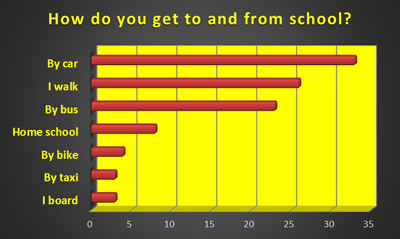How do children travel to school?
How do children get to and from school?

The issue of how children get to and from school is often up for discussion. Few children live withing walking distance of their school so some kind of transportation is required. But which one do parents favour?
There are lots of issues to consider. Many parents complain about the amount of traffic around their school caused by parents dropping off or picking up their children. The environment is another concern, and we are encouraged to use public transport to help save the planet. But the main issue of course is the safety of our children.
In our latest survey we wanted to discover which method of transport is the most popular. We asked 8,958 children how they make the daily journey to school and back. This is what we found out:
3% of our respondents attend boarding schools so do not have to make the daily journey. Equal on 3% were children whose parents pay for a taxi to take them to school and back. 4% of children use a bicycle to make the journey. 8% are schooled at home so do not have to arrange transport. 23% use the free school buses provided by their local councils. Just over a quarter of children (26%) live close enough to walk to school and a whopping 33% are driven to and from school in ther parents’ cars.
Pros and cons of driving children to and from school
We’ve all heard the arguments against driving our children to school. But the truth is that a third of parents do exactly that. So there must be very good reasons for doing so. To clarify matters, and to keep parents informed, we’ve made a short list of the benefits and the disadvantages of driving children to and from school.
Arguments against
Environment. There is no doubt that cars which carry fewer people than buses are detrimental to the environment. Not only by the fossil fuels they burn but also the pollutants they emit in their exhaust fumes. These negatively affect air quality and harm thousands of people every year.
Traffic. As anybody who has passed a school at pick up or drop off times will know, there can be huge amounts of traffic outside schools. The road where my daughter’s school is is often blocked by the sheer volume of cars and many of them park in places where they are a danger to other road users and pedestrians.
Lack of exercise. According to the charity Living Streets, 70% of children walked to and from school just one generation ago. Now it is just a quarter, despite the majority of primary school children living withing 20 minutes walking distance of their school. If THIS is too long a distance to walk then one wonders ho much exercise children are getting.
Arguments for
Safe from bullies. Bullying is an ever-present concern. School buses can be the haunts of bullies, and lone children walking to school are at risk from bullying too. The less time your child spends away from you or the safety of the school, the safer they are from bullies.
Safe from accidents. This one is a little ironic. Because school drop-off zones are so busy, they have become dangerous places. According to figures provided by insurers, over 1,000 children a month are injured on roads around UK schools. If they are in a car then they are much safer.
Safe from predators. This is every parent’s worst nightmare. It is very rare, thankfully, but there are predators who abduct lone children on their way to or from school. If you are with your child then this ceases to be a risk.
More Survey ResultsFull Results of our "How do you get to and from school?" Survey
Here are the results from 8,958 children who answered our question "How do you get to and from school?". The survey was conducted in the 4-weeks ending October 10th, 2020.
| How do you get to and from school? | Percentage of Respondents |
|---|---|
| I go to boarding school | 3 |
| By taxi | 3 |
| By bicycle | 4 |
| Home-schooled | 8 |
| By bus | 23 |
| I walk | 26 |
| By car | 33 |



